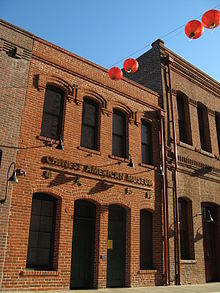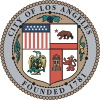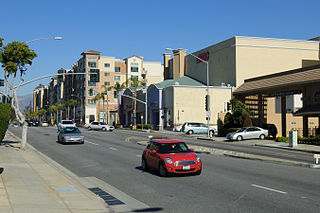
Monterey Park is a city in the western San Gabriel Valley region of Los Angeles County, California, United States, approximately seven miles (11 km) east of the Downtown Los Angeles civic center. It is bordered by Alhambra, East Los Angeles, Montebello and Rosemead. The city's motto is "Pride in the past, Faith in the future".

Rowland Heights is an unincorporated area in and below the Puente Hills in the San Gabriel Valley, in Los Angeles County, California, United States. The population was 48,231 at the 2020 census. Rowland Heights is in the Los Angeles metropolitan area and represented by the County of Los Angeles and is the second largest census designated place in Los Angeles County by area, behind Topanga, and the county's fifth largest CDP by population. The area has a high Taiwanese population and was known as “Little Taipei” in the 1980s and 1990s, when it saw an influx of wealthy immigrants from Taiwan.
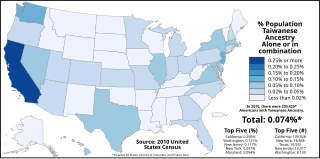
Taiwanese Americans are an ethnic group in the United States consisting of Americans with ancestry from Taiwan, including American-born citizens descended from Taiwanese migrants.
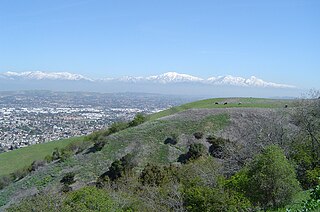
The San Gabriel Valley, often referred to by its initials as SGV, is one of the principal valleys of Southern California, with the city of Los Angeles directly bordering it to the west, and occupying the vast majority of the southeastern part of Los Angeles County. Surrounding landforms and other features include the following:

Chinatown is a neighborhood in Downtown Los Angeles, California, that became a commercial center for Chinese and other Asian businesses in Central Los Angeles in 1938. The area includes restaurants, shops, and art galleries, but also has a residential neighborhood with a low-income, aging population of about 7,800 residents.

Sam Woo Restaurant (三和) is a restaurant chain that serves Hong Kong–style cuisine. It has many locations in predominantly overseas Chinese communities of Southern California, in Las Vegas, and in the suburbs of Toronto. "Sam Woo" is a romanization of the Cantonese pronunciation for "triple harmonies," in reference to feng shui principles, including the synthesis of heaven, earth, and humanity. The complete Chinese name (三和燒臘麵家) would translate literally into English as "Three Harmonies Roast Meats and Noodle House."

Hong Kong Supermarket is an Asian American supermarket chain started in the San Gabriel Valley region of Southern California. It operates mainly in the newer suburban overseas Chinese communities, particularly in the Los Angeles, Philadelphia, and New York City areas. Hong Kong Supermarket specializes mainly in imported Asian groceries. Many items are from Mainland China, Hong Kong, Macau, Japan, South Korea, Thailand, Taiwan, Vietnam, Indonesia, and the Philippines.

Shun Fat Supermarket is a Chinese Vietnamese American supermarket chain in the San Gabriel Valley region in California, Little Saigon, Orange County, California, Sacramento, California, San Pablo, California, Las Vegas, Nevada, Portland, Oregon and Garland, Texas.
Frederic Shu Kong Hsieh was a Chinese-born American realtor and investor who "founded" the first Chinese American suburban community of Monterey Park, California by purchasing and reselling plots of abandoned land in the city at premium prices to Chinese investors from Taiwan. In addition, he heavily promoted Monterey Park in newspapers of Hong Kong and Taiwan to encourage prospective Chinese emigrants to move to the city. In the early 1970s, he predicted that the then-predominantly Caucasian city of Monterey Park and the San Gabriel Valley would serve as an anchor for new ethnic Chinese immigrants as an alternative to the old Chinatown in Los Angeles, but it was immediately dismissed and brushed off as mere speculation at the time.

The Asian-American influx into the southwestern portion of the San Gabriel Valley region of Los Angeles County, California, grew rapidly when Chinese immigrants began settling in Monterey Park in the 1970s. Just east of the city of Los Angeles, the region has achieved international prominence as a hub of overseas Chinese, or hua qiao. Although Chinese immigrants were a noteworthy presence in the establishment of Southern California from the 19th century, significant Chinese migration to suburban San Gabriel Valley coincided with a trend of white out-migration from the 1970s onward. This opened an opportunity for middle-class Asian Americans to begin settling in the San Gabriel Valley.

Wah Ching is a Chinese American criminal organization and street gang that was founded in San Francisco, California in 1964. The Wah Ching has been involved in crimes including narcotic sales, racketeering, and gambling.

The Los Angeles Chinese massacre of 1871 was a racial massacre targeting Chinese immigrants in Los Angeles, California, United States that occurred on October 24, 1871. Approximately 500 white and Latino Americans attacked, harassed, robbed, and murdered the ethnic Chinese residents in what is today referred to as the old Chinatown neighborhood. The massacre took place on Calle de los Negros, also referred to as "Negro Alley". The mob gathered after hearing that a policeman and a rancher had been killed as a result of a conflict between rival tongs, the Nin Yung, and Hong Chow. As news of their death spread across the city, fueling rumors that the Chinese community "were killing whites wholesale", more men gathered around the boundaries of Negro Alley.
Valley Boulevard is a street in Southern California, running east from Los Angeles to Pomona, where it becomes Holt Avenue, and a continuation from Fontana to Colton. It generally parallels Interstate 10 (I-10) and State Route 60 (CA 60), and is the original alignment of U.S. Route 60 (US 60). The present north end of I-710 is at Valley Boulevard in Los Angeles, just west of Alhambra.

Chinatowns are enclaves of Chinese people outside of China. The first Chinatown in the United States was San Francisco's Chinatown in 1848, and many other Chinatowns were established in the 19th century by the Chinese diaspora on the West Coast. By 1875, Chinatowns had emerged in eastern cities such as New York City, Boston, Pittsburgh, and Philadelphia. The Chinese Exclusion Act of 1882 barred Chinese immigration to the United States, but the Magnuson Act of 1943 repealed it, and the population of Chinatowns began to rise again.
Asian Californians are residents of the state of California who are of Asian ancestry. California has the largest Asian American population in the United States, and second highest proportion of Asian American residents, after Hawaii. As of the 2020 US census, there were over 6 million Asian Americans in California; 15.5% of the state's population. If including those with partial Asian ancestry, this figure is around 17%. This is a jump from 13.8% recorded in 2010.
The 1990 United States census and 2000 United States census found that non-Hispanic whites were becoming a minority in Los Angeles. Estimates for the 2010 United States census results find Latinos to be approximately half (47-49%) of the city's population, growing from 40% in 2000 and 30-35% in 1990 census.
There is a large Taiwanese and Taiwanese American community in the Greater Los Angeles Area. The Los Angeles-Long Beach-Santa Ana metropolitan area had a Taiwanese population of 83,294 as of 2008. At 24.3% of the total Taiwanese-American population, the Taiwanese community in Greater Los Angeles represents the largest Taiwanese community in the United States.
Chinese American church refers to Christian churches in the United States made up of predominantly ethnic Chinese congregations. The term is primary used to describe certain Protestant congregations found in large American cities, with a majority Chinese membership, and who typically offer bilingual services in both English and Chinese.

Old Chinatown, or original Chinatown, is a retronym that refers to the location of a former Chinese-American ethnic enclave enforced by legal segregation that existed near downtown Los Angeles, California in the United States from the 1860s until the 1930s. Old Chinatown included the former Calle de los Negros and extended east across Alameda Street to Apablasa, Benjamin, Jeannete, Juan, Marchessault, and Macy Streets. This Chinatown was at its commercial and communal peak between 1890 and 1910.


